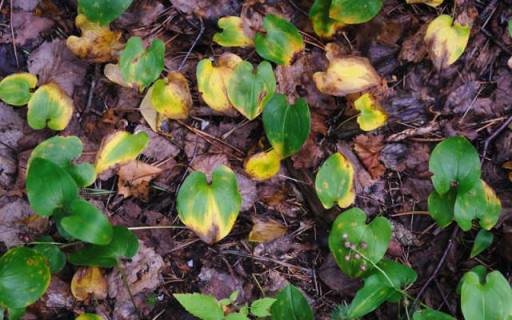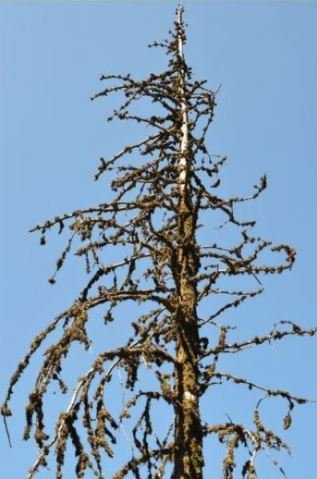Apart From Humans, Pollution Affects Plants Extremely Too
A major threat to our existence on planet earth is pollution. We are constantly faced with different types of pollution; from air pollution to water pollution and land or soil pollution. These various forms of pollution have their effects on our environment and on living organism present in the biosphere.

Despite the generic nature of pollution effects, we often times concentrate so much more on the menace that pollution bring to us as humans, and we forget that other living organisms besides mammals (animals), most notably plants, do experience debilitating effects of constant environmental pollution.
The effects of pollutions from exhausts of cars, fuel and gas combustions, industrial emissions, fumes from indiscriminate burning and other sources, often cloaks the skyline of most cities, especially in developing countries in brown.
Air pollution results in the deposition of black soot, and residual contaminants in our waterbodies, on plants and around our surroundings.
Apart from the fact that air pollution affects humans and causes various forms of respiratory diseases, it also has adverse effects on plants.
The negative effects of pollution on plants takes time to develop and is usually permanent in nature; meaning that adverse effects of pollution on plants can’t be reversed.
According to a research by a chemist from the Kent State University, Fred Davis, some plants are more prone and susceptible to damage from pollution than others.
Forms of Pollutions
Land or Soil Pollution
Indiscriminate land pollution such as oil spills, illegal dumping, use of pesticides, etc, cause various kinds of chemicals to seep into the soil and leach soil nutrients. Also, chemicals and metals from the pollutants which contaminate the soil poison and damage plant cells, leading to alteration of plant metabolism and low yields.
Air Pollution
Smokes and fumes from factories, exhausts of cars, gas emissions and other sources, emission of chemicals like carbon, nitrogen oxides, and sulfur which damage plants visibly, by causing stunted growth, colour alteration, mottling, reddening, and bronzing. Ozone damages plant through prevention of respiration, photosynthesis, obstruction of stomata – leading to slow and stunted growth.
Water Pollution
Industrial spills, sewage leaks, farm runoff, bio-contamination and direct discharge into water bodies are various forms of water pollution. Water pollution poses several negative effects, such as excess of nutrients in water. Polluted water with excess nutrients can result in an excess in plant growth, as well as a fluctuation in acidity of soil water which damages and kills plants.
Acid Rain
Water from the air which combines with sulfur oxide and nitrogen oxide in the atmosphere causes acid rain. Acid rain on reaching the earth surface damages soil quality by dissolving and washing nutrients away; it contaminates soil water, ruining plant metabolism; it also damages plants when in direct contact with leaves, and makes plant photosynthesis and plant exchange of gases difficult, leading to plant death.
How Pollution Affects Plants
1.) It leads to infestation by insects
When plants are weakened by air pollution, it makes them susceptible to attacks and infestation from insects. A study by the University of Colorado revealed that insects like pine bark beetles damage pine trees that have been stressed and weakened by air pollution.
In 2008 a story published by Newsweek revealed that about 22 million acres of pine trees have been destroyed in Canada, while over 1.5 million acres have been ruined in Colorado, U.S. by pine bark beetles.
2.) Damage to leaves
Air pollutants and chemicals such as fluorides, ozone, sulphur dioxide and nitrates damage the leaves of plants. When a large portion of the leaves of plants are damaged or destroyed, the plant will die. A chemical like sulphur dioxide is a by-product of fossil fuels like gasoline, coal and oil, and when in contact with the leaves of plants, it causes the colour of the leaf tissue to change to either white, brown or yellow.
Also, Sulphur dioxide can turn to sulfuric acid which eats leaves creating holes in them. Leaves that get damaged from Ozone appear as mottle yellow, black or brown spots. On occasions when the damage of Ozone is severe, the plant loses its leaves altogether.
Fluoride consumes the edges of leaves causing them to turn black or brown. Peroxyacyl nitrate damages leaves via a condition known as silver leaves, where the leaves’ underside turns bronze or silvery white.
3.) Stunted and slowed growth
Studies have shown that a by-product of fuel combustion from cars or fires is nitrogen dioxide which can slow plants’ growth. But nature has a remediating procedure to that, because nitrogen dioxide is converted to nitric acid by rainfall. The converted nitric acid then adds nitrogen to the soil which is very essential for plant growth.
However, carbon monoxide is not as beneficial to plants and man. This is because carbon monoxide (CO) is poisonous to humans and also stunts the growth of plants. Lots of evergreens lose their leaves when in contact with carbon monoxide.
References
- http://www.sustainablebabysteps.com/kinds-of-environmental-pollution.html
- http://www.livestrong.com/article/141726-the-effects-air-pollution-plants/
- http://www.air-quality.org.uk/15.php
- http://www.everythingconnects.org/soil-pollution.html
- http://education.seattlepi.com/water-pollution-affect-plants-life-cycle-4815.html
- https://greentumble.com/effect-of-pollution-on-plants/
- https://www.intechopen.com/books/the-impact-of-air-pollution-on-health-economy-environment-and-agricultural-sources/the-effects-of-air-pollutants-on-vegetation-and-the-role-of-vegetation-in-reducing-atmospheric-pollu
Thank you for your time and for reading my post.
If you found this post interesting, then kindly UPVOTE, RESTEEM and FOLLOW @rickie, for more quality posts.
You Can Check Out My Other Posts Below:
- Treatment Of Ponds And Water Using Aquatic Plants
- Electronic Cigarette: History, How it Works, and Risks
- A Smart-Phone Compatible System Detects Bacteria In Food
- With New Technology, Cancer Can Be Spotted Several Months Before It Occurs
- Synthetic Alcohol That Doesn't Give Hangover Will Replace Present-Day Alcohol In A Few Years
- Tomatoes and Apples Could Help Repair Lung Damage in Ex-Smokers


I think that concern for the environment is important because they are also part of a living being but more importantly what about us humans who are part of a living being.
I agree @murtaza. Plants are essential to our existence and without them, we probably won't be existing. So, yes, concern for our environment - which includes plants - is important. Thanks for reading.
plants exist for the sake of human comfort. I see what you mean. Thank you @rickie
Yes and this is what gives our world the oxygen we need!!
You are quite right @bitdollar. Thanks for reading.
You did a good job. Keep it up. Can I resteem your post ?
Thanks for reading @htuan.